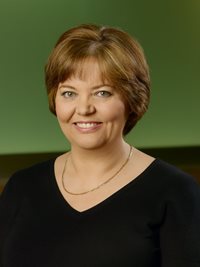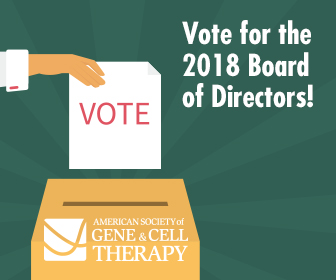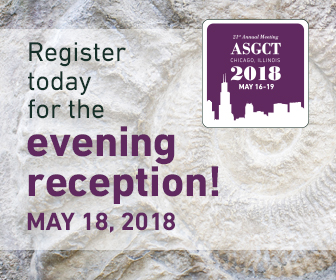The Vector
Volume 7, Issue 2: March 2018
Editorial Team
Guohua Yi, PhD - Editor, The Vector
Phillip Doerfler, PhD - Associate Editor, The Vector
Melvin Rincon, MD, PhD - Junior Editor, The Vector
Inside This Issue
President's Message
Breaking Through
Society News
Public Policy
Industry News

President's Message

Dear Colleagues,
With spring comes the Society’s annual election of officers and directors, and the nominations committee has done an outstanding job in securing a highly qualified slate of candidates that includes Barry Byrne, MD, PhD or Stephen Russell, MD, PhD for Vice President; Timothy Hunt, JD or Richard Morgan, PhD for Translational and Clinical Development Representative; Jennifer Adair, PhD or Suk See De Ravin, MD, PhD for At-Large Director; and Stephen Hart, PhD or John Maher, PhD also for At-Large Director. To cast your ballot please visit the Members Only section of the ASGCT website. The election will remain open through April 10.
I am also delighted to announce the selection of the 2018 ASGCT Awardees, reflecting outstanding achievements in our field. This is a very appropriate year to honor Jean Bennett, MD, PhD who has been selected as the recipient of the Outstanding Achievement Award. Dr. Bennett has pioneered the development of gene therapy strategies for inherited ocular diseases and her progress from preclinical models to testing in a canine model and then first-in-man studies has now culminated in the first FDA approval of an AAV gene therapy to improve vision in patients with established genetic vision loss due to confirmed biallelic RPE65 mutation-associated retinal dystrophy. This is both the first gene therapy approved in the U.S. to target a disease caused by mutations in a specific gene and the first using an AAV vector. I look forward to presenting her with the award in person and listening to her presentation during the Annual Meeting. The Outstanding New Investigator award recognizes investigators for contributions within the first ten years of becoming independent investigators and this year we honor two accomplished young investigators: Luca Biasco, PhD and Luk Vandenberghe, PhD. Dr. Biasco has exploited insertion site analyses from human gene therapy trials to produce new insights into human hematopoiesis and immune cells while Dr. Vandenberghe has made significant contributions to AAV biology and vector design to target rare retinal diseases and hearing disorders. Lastly, we acknowledge the Fondazione Telethon and its General Director, Dr. Francesca Pasinelli with the Sonia Skarlatos Public Service Award. Telethon has had a key role in advancing gene and cell therapy for rare genetic diseases in Europe and throughout the world. Please join me in congratulating this most distinguished class of awardees.
Lastly, our 21st Annual Meeting is just two months away! Please make sure you register so you do not miss out on the ground breaking clinical trial results, cutting edge technology advancements, social networking events, and much more. The full program is now available online. I look forward to seeing you there.
Breaking Through
CRISPR-Cas9 base editing for reducing blood lipid levels
Chadwick AC, Evitt NH, Lv W, Musunuru K. Reduced blood lipid levels with in vivo CRISPR-Cas9 base editing of ANGPTL3. Circulation 2018; 137:975-977.
Summary written by Alexandra C. Chadwick and Kiran Musunuru
Although many therapies exist to help combat high plasma lipid levels, coronary heart disease continues to be the leading cause of death in the United States and worldwide. Proprotein convertase subtilisin/kexin type 9 (PCSK9) and angiopoietin-like 3 (ANGPTL3) are two highly attractive candidates for therapeutic targeted disruption, as patients with naturally occurring loss-of-function mutations in these genes have reduced circulating lipids and are better protected against coronary heart disease1. Indeed, current treatments using small molecules or antibody-based targeting have proven successful in reducing blood low density lipoprotein (LDL)-cholesterol levels in patients, but their limitations include the need for repeated injections over the lifetime, and they might not work optimally for many individuals.
Therapeutic genome editing is now becoming a compelling alternative to current pharmaceutical interventions, as permanent alteration of genes could potentially produce lifelong protection against particular diseases and can even offer cures where no current therapies exist. However, use of standard genome-editing technologies such as clustered regularly interspaced short palindromic repeats (CRISPR)-CRISPR-associated 9 (Cas9) has the major concern of unintentional off-target mutagenesis due to the induction of double-strand breaks in the genome. Recently described “base editors” build upon CRISPR-Cas9 technology and may offer an efficient, safer approach to therapeutic genome editing2. These base editors, comprising an RNA-editing domain tethered to a catalytically impaired Cas9 protein, can introduce specific point mutations at precise locations in the genome, and since they do not require double-strand DNA breaks, base editing should be a safer alternative to standard CRISPR-Cas9 editing due to reduced off-target mutagenesis.
In our recent work, we sought to determine if base editing could be harnessed as a potential treatment for atherogenic dyslipidemia. We used the base-editing technology to specifically introduce nonsense mutations in codons encoding glutamines (CAG to TAG or CAA to TAA) or tryptophans (TGG to TAG, TGG to TGA, or TGG to TAA) for targeted disruption of PCSK9 and ANGPTL3. In our first set of experiments3, we injected mice with an adenoviral vector containing the base editor and a guide RNA targeting Pcsk9 that exhibited high editing activity in vitro. After one week, more than 30% of the Pcsk9 alleles were edited in the liver, which decreased circulating PCSK9 protein by greater than 50% and resulted in a 30% decrease in cholesterol levels as compared to controls. Importantly, deep sequencing analysis of ten of the top predicted off-target sites showed no off-target mutagenesis. This first proof-of-principle experiment established that PCSK9 disruption by base editing could decrease cholesterol levels substantially and in a potentially safer way than classical genome-editing techniques.
However, since PCSK9 regulates plasma LDL-cholesterol through antagonism of the LDL receptor (LDLR), patients suffering from familial hypercholesterolemia caused by complete loss-of-function LDLR mutations would not benefit from therapies aimed at disrupting PCSK9. In these patients, ANGPTL3 is a more viable candidate for reducing plasma LDL-cholesterol and, as a bonus, triglycerides levels, via mechanisms independent of the LDLR pathway. In our most recent study4, we employed the same base-editing strategy to disrupt Angptl3. We injected mice with an adenovirus encoding the base editor and a guide RNA targeting Angptl3 that exhibited significant activity in vitro. After seven days, a robust 49% average reduction in circulating ANGPTL3 was observed, along with 31% and 19% reductions in circulating triglycerides and cholesterol, respectively. Even more impressively, Angptl3 disruption in hyperlipidemic Ldlr-knockout mice (a model of familial hypercholesterolemia) showed a substantial 56% reduction in triglycerides and 51% reduction in cholesterol, making ANGPTL3 a strong candidate for therapeutic targeting in atherogenic dyslipidemia. In all of these experiments, no off-target mutagenesis was observed by deep sequencing of the top predicted off-target sites.
Taken together, our recent work has illustrated that base editing is a strong contender for therapeutic genome-editing strategies and that targeted disruption of PCSK9 or ANGPTL3 can significantly reduce blood lipid levels. With the efficient introduction of specific point mutations without the need for double-strand breaks, targeted disruption of these genes may be a promising, safe strategy in the treatment and prevention of coronary heart disease.
References
- Musunuru K, Kathiresan S. Cardiovascular endocrinology: is ANGPTL3 the next PCSK9? Nat Rev Endocrinol. 2017; 13:503–504.
- Komor AC, Kim YB, Packer MS, Zuris JA, Liu DR. Programmable editing of a target base in genomic DNA without double-stranded DNA cleavage. Nature. 2016; 533:420–424.
- Chadwick AC, Wang X, Musunuru K. In vivo base editing of PCSK9 as a therapeutic alternative to genome editing. Arterioscler Thromb Vasc Biol. 2017; 37:1741–1747.
- Chadwick AC, Evitt NH, Lv W, and Musunuru, K. Reduced blood lipid levels with in vivo CRISPR-Cas9 base editing of ANGPTL3. Circulation. 2018; 137:975-977.
Long-term correction of diabetes in mice by in vivo reprogramming of pancreatic ducts
Wang Y, Dorrell C, Naugler WE, Heskett M, Spellman P, Li B, Galivo F, Haft A, Wakefield L, Grompe M, Long-term correction of diabetes in mice by in vivo reprogramming of pancreatic ducts, Molecular Therapy (2018), doi: 10.1016/j.ymthe.2018.02.014
Summary written by Y Wang & M Grompe.
Pancreatic β cells are essential for blood glucose control and defects in these cells account for most, if not all, forms of diabetes. Type 1 diabetes (T1D) is an autoimmune disease characterized by massive β-cell loss and severe insulin deficiency. It remains the most common form of diabetes in children and affects approximately 1.25 million children and adults in the U.S1. Untreated T1D patients are severely hyperglycemic and show devastating complications/co-morbid conditions, such as weight loss, fatigue, blindness, kidney failure and stroke.
β cell regeneration holds great promise in permanently treating T1D. One of the major approaches to generate β cells de novo is direct lineage reprogramming, in which non-β cells are lineage converted into β-like cells through activation of β cell identity-specifying genes and/or repression of donor cell genes. Other cell types in the pancreas are of great interest in β cell regeneration due to their developmental proximity to β cells. In particular, pancreatic ducts have been shown previously as a potential source to generate insulin-producing cells in vitro 3,4.
In this article, the authors report in vivo reprogramming of pancreatic ducts into functional β cells through induction of pancreatic transcription factors Pdx1, Neurog3 and Mafa (PNM). Reprogramming factors PNM were packaged in a single adenoviral vector and delivered directly into the pancreatic duct through retrograde ductal injection. This leads to specific targeting of pancreatic ductal cells and induction of insulin expression. To directly determine the origin of induced insulin+ cells, the authors conducted lineage tracing experiment with the pancreatic duct reporter strain Sox9-CreERT2/mTmG and demonstrate that around 88% of induced insulin+ cells are pancreatic ducts in origin.
Induced insulin+ cells are mono-hormonal and show both molecular and functional features of β cells. In order to extensively assess the reprogramming extent, the authors performed single-cell gene expression profiling on induced insulin+ cells and show that reprogrammed cells have acquired a β cell phenotype by activating β cell transcription factors as well as functional markers, such as genes involved in glucose sensing and insulin secretion. Induced insulin+ cells also suppressed the original pancreatic duct gene expression program. In addition, induced insulin+ cells are highly functional and PNM delivery using this approach rapidly restored normoglycemia in two different diabetic animal models for at least 2 months.
Another interesting aspect of this report is the comparison of the reprogramming outcome among different cell types. The authors explored the possibility of reprogramming hepatocytes and intrahepatic ducts in comparison with pancreatic ducts. Interestingly, compared to intrahepatic ducts and hepatocytes treated with the same vector, pancreatic ducts demonstrate more rapid activation of β-cell transcripts and repression of donor cell markers. These observations indicate that the origin of donor cells may influence the reprogramming outcome.
This work is a first demonstration that pancreatic ductal cells can be targeted in vivo using a gene therapy approach for treating diabetes in mouse models. Further studies will be needed to develop clinically safe viral vector system as well as assess whether the newly formed β cells are susceptible to autoimmune attack. This method could be readily applicable to humans through the commonly performed procedure, endoscopic retrograde cholangiopancreatography (ERCP) and provides potential for development of clinically feasible cell replacement therapy in T1D patients.
- Centers for Disease Control and Prevention. National Diabetes Statistics Report, 2017. Atlanta, GA: Centers for Disease Control and Prevention, US Department of Health and Human Services. (2017).
- Zhou, Q., Brown, J., Kanarek, A., Rajagopal, J. & Melton, D. A. In vivo reprogramming of adult pancreatic exocrine cells to beta-cells. Nature 455, 627-632, doi:10.1038/nature07314 (2008).
- Lee, J. et al. Expansion and conversion of human pancreatic ductal cells into insulin-secreting endocrine cells. Elife 2, e00940, doi:10.7554/eLife.00940 (2013).
- Dorrell, C. et al. The organoid-initiating cells in mouse pancreas and liver are phenotypically and functionally similar. Stem Cell Res 13, 275-283, doi:10.1016/j.scr.2014.07.006 (2014).
Society News

Voting is Now Open for ASGCT's 2018 Elections
Voting for the 2018 ASGCT election is now open for members at ASGCT.org. The ballot is also available in the Members Only section of the website. Balloting will be open through April 10. Members are invited to select one candidate in each of the following elections:
Vice President
- Barry Byrne, MD, PhD—University of Florida College of Medicine
- Stephen Russell, MD, PhD—Mayo Clinic
Translational and Clinical Development Representative
- Timothy Hunt, JD—Editas Medicine
- Richard Morgan, PhD—bluebird bio
At-Large Director
- Jennifer Adair, PhD—Fred Hutchinson Cancer Research Center
- Suk See De Ravin, MD, PhD—National Institutes of Health
At-Large Director
- Stephen Hart, PhD—UCL Great Ormond Street Institute of Child Health
- John Maher, PhD—King's College London
Candidate position statements and CV information is available on the ballot. Please note that only ASGCT Members and Transitional Members who have paid their 2018 membership dues are eligible to vote. You may renew your membership online via the ASGCT website. Once your membership is current, you will be able to vote immediately.
Employment Center
The Annual Meeting Employment Center is a resource for employers to connect with applicants on specific open positions before and during the ASGCT 21st Annual Meeting. Employers who register for the Employment Center may post open positions on the ASGCT Job Board online, view resumes of applicants who are participating in the Employment Center, and utilize a table in the Annual Meeting Employment Center to conduct in-person interviews with applicants. Applicants can apply for open positions online through the ASGCT Job Board and meet with potential employers on-site at the 21st Annual Meeting. Interested employers and applicants must register for the Annual Meeting Employment Center in order to participate in the on-site Employment Center. Visit the website for more information about the Employment Center.

Get Your Ticket Now to ASGCT’s Evening Reception at the Chicago Field Museum!
The Evening Reception will take place at the Field Museum on Friday, May 18, 2018 from 8 - 11 pm. Cost is $25 per ticket. Transportation will be provided. Space is limited so buy your ticket soon!
Trainee Lounge Highlights
The Trainee Lounge will offer undergraduates, medical and graduate students, and post-doctoral fellows educational and career-developing networking opportunities at the Annual Meeting. The New Investigator Committee has created three lunch sessions throughout the Annual covering grant writing, the mock review session, and industry interaction. These lunch sessions are FREE to Associate Members. Registration for the lunch sessions is available during Annual Meeting sign up. Space is limited to 50 attendees per lunch session. The Trainee Lounge will offer snacks and refreshments throughout the day. Trainees are encouraged to stop-by, practice their poster presentations, and network with other Trainees.
Public Policy
ASGCT Supports Research Funding and Patient Access
Through its recent support of three piece of legislation, ASGCT is advocating for funding of biomedical research and increased access for patients once that research reaches clinics. Alongside 29 other organizations, ASGCT endorsed the National Biomedical Research Act of 2017. This bill would provide a new funding stream of $5 billion annually for ten years to a Biomedical Research Fund to be distributed to the NIH and FDA, supplementing existing appropriations. The funding would be targeted to select research categories, including “disruptive innovation”—breakthrough research on diseases with unmet medical needs or for which current treatments are inadequate.
Additionally, ASGCT signed on to a letter of support, along with 66 other organizations, to sponsors Senator Cory Booker (D-NJ) and Senator Tim Scott (R-SC) for the Sickle Cell Disease Research, Surveillance, Prevention, and Treatment Act. Among other provisions, this legislation would enhance research and surveillance efforts, which would improve the current understanding of this life-long disease and potentially identify more curative options. At this time, hematopoietic stem cell transplantation is the only cure. Several gene therapy trials are now underway for sickle cell disease (SCD), with promising early results. The House of Representatives last month passed a companion bill on the measure.
Last month, ASGCT sent a letter of support to sponsor Congressman Erik Paulsen (R-MN) regarding the Protecting Access to Cellular Therapies (PACT) Act. This legislation would ensure that hospitals providing hematopoietic cell transplantations (HCTs) to Medicare beneficiaries receive adequate payments, similar to those hospitals receive for solid organ transplants, which cover both cell acquisition costs and the inpatient hospital stay. Cell acquisition costs for HCTs currently consume all or most of the Medicare reimbursement rate.

ASGCT Joins Rare Disease Advocates Voice Needs to Legislators in Washington, DC
ASGCT representatives joined more than 450 attendees to the Rare Disease Legislative Conference and Lobby Day the end of last month, sponsored by the EveryLife Foundation for Rare Diseases. Among other requests, attendees to meetings with legislative staff requested robust research funding to the National Institutes of Health and support of the Orphan Product Extensions Now - Accelerating Cures and Treatment Act (OPEN Act). NIH funding supports biomedical research, including for gene therapies that have the potential for treating a variety of rare diseases. The OPEN Act would provide an additional six months of market exclusively for an already approved a drug or biological product that is repurposed to treat a rare disease, providing an incentive for rare disease drug development. Both measures support the development of treatments, now lacking for 95 percent of rare diseases.
ASGCT Submits Comments on FDA Draft Guidance on Regenerative Medicine Expedited Programs
ASGCT leadership submitted comments to the FDA last month on the draft guidance titled, “Expedited Programs for Regenerative Medicine Therapies for Serious Conditions.” ASGCT expressed appreciation for guidance on these programs, especially on the Regenerative Medicine Advanced Therapy (RMAT) designation and the inclusion of certain gene therapies in the eligibility for consideration for RMAT designation. The guidance identifies gene therapies, including genetically modified cells, which lead to a durable modification of cells or tissues, as eligible for RMAT designation. A primary recommendation of ASGCT is to expand the eligibility for RMAT designation to all gene therapies to encourage the development of such therapies, which hold the potential to provide treatment for significant unmet need for multiple diseases. Visit ASGCT’s Regulatory Updates page for links to additional recent FDA guidance documents related to gene and cell therapy.
Participate in ARM’s Fly-In in Collaboration with ASGCT
Register to attend a Legislative Fly-In presented by the Alliance for Regenerative Medicine (ARM) in collaboration with the American Society of Gene & Cell Therapy on May 23. Registration for the event includes a full day of meetings leading up to the ARM Annual Dinner on May 22, including a keynote address by FDA Commissioner Scott Gottlieb. At the Fly-In, meet with key members of Congress and Administration officials to voice the need for legislation that supports the development of gene and cell therapies. As an organizational member of ARM, ASGCT members will receive the ARM membership rate.
FDA Announces Pilot for Orphan Designation Requests
FDA Commissioner Scott Gottlieb announced last month new actions the FDA is taking to support and expedite development of rare disease products, including a new pilot for more efficient orphan designation requests. A new fillable form will ease the submission process for sponsors completing designation requests, and increase the efficiency of FDA review. The FDA also launched a new online tutorial to guide sponsors through the orphan designation process. For more regulatory news related to the field, visit ASGCT’s Regulatory Updates page.
Industry News